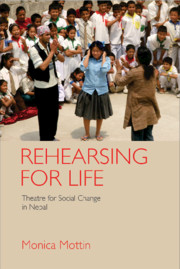Book contents
- Frontmatter
- Dedication
- Contents
- List of Tables, Figures and Boxes
- Acknowledgements
- Chapter 1 Theatre and Life: Theatre at the intersection of art, politics and international development
- Chapter 2 Spacing Out to Speak Up: Resistance, protest and the emergence of street theatre
- Chapter 3 The Streets Become the Stage: Performance, protest and theatre in a time of political crisis
- Chapter 4 Kachahari Natak: Fragments of an aesthetics of theatre for social change
- Chapter 5 Activism not Development Work: Explorations in Tharu kachahari natak
- Chapter 6 A Cultural Army for a Cultural Revolution: Maoist cultural programmes and revolutionary theatre
- Chapter 7 The Ordinariness of the Special: Towards the professionalization of theatre work
- Chapter 8 Conclusions
- Bibliography
- Index
Chapter 8 - Conclusions
Published online by Cambridge University Press: 05 April 2018
- Frontmatter
- Dedication
- Contents
- List of Tables, Figures and Boxes
- Acknowledgements
- Chapter 1 Theatre and Life: Theatre at the intersection of art, politics and international development
- Chapter 2 Spacing Out to Speak Up: Resistance, protest and the emergence of street theatre
- Chapter 3 The Streets Become the Stage: Performance, protest and theatre in a time of political crisis
- Chapter 4 Kachahari Natak: Fragments of an aesthetics of theatre for social change
- Chapter 5 Activism not Development Work: Explorations in Tharu kachahari natak
- Chapter 6 A Cultural Army for a Cultural Revolution: Maoist cultural programmes and revolutionary theatre
- Chapter 7 The Ordinariness of the Special: Towards the professionalization of theatre work
- Chapter 8 Conclusions
- Bibliography
- Index
Summary
A day will come when our societies will know again those hours of creative effervescence in the course of which new ideas arise and new formulae are found which serve for a while as a guide to humanity.
Durkheim, 1976, 427–28One feeling guided my experience of doing fieldwork in Nepal in those strange times of swift political change: that transformation seemed to move like a vortex, and there seemed to be no permanency. One day you could wake up isolated from the whole world, and the political scenario could turn upside down, what the king said, was not what he meant. Once I asked one of my research participants if I could quote a controversial remark. They were surprised. ‘Why not?’ adding that if I would ask the same question the day after, they may change their mind and give a totally different answer. There seemed to be no certainty beyond present visibility. And even what was visible sometimes seemed a fleeting representation of something else – one among a myriad possible representations. For this reason, I think, performance, and theatrical performance in particular, well interpreted the mood of the time. A piece of theatre is a multi-vocal, multi-spatial representation that leaves open as many possible interpretations as there are spectators. It does not entail a long-term commitment, and you cannot easily fix it. But for the same reasons, theatre could also create subtle emotional threads, bring back memories of the past, and sustain dreams and hopes. The perception of such a fast change did not correspond with the pace of actual change: imagination and expectations moved quickly, the changes in the material realities were slower and such a gap caused disillusionment.
In this concluding chapter, I am going to draw parallels between the different performances that I have documented, namely loktantrik natak, kachahari natak, and Maoist cultural programmes to understand what an aesthetics of theatre for social change would entail and what we can learn from comparing theatre in development with theatre in social and political movements. I will then discuss the tension between professionalism and activism in the arts. I will assert that despite kachahari natak becoming less participatory in Aarohan's adaptation, Aarohan artists were themselves rehearsing for their own lives when they practicing it in this way. They were led by their own aspirations and passion, just like political and social activists.
- Type
- Chapter
- Information
- Rehearsing for LifeTheatre for Social Change in Nepal, pp. 247 - 254Publisher: Cambridge University PressPrint publication year: 2017

